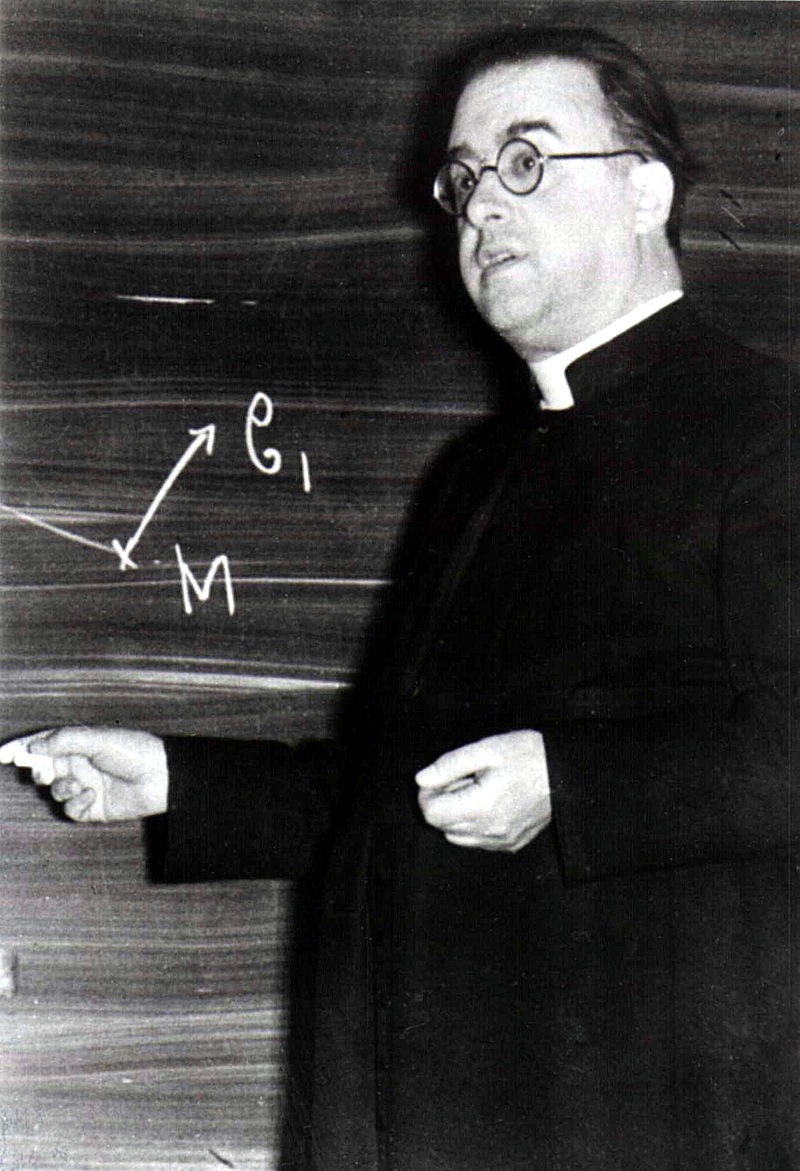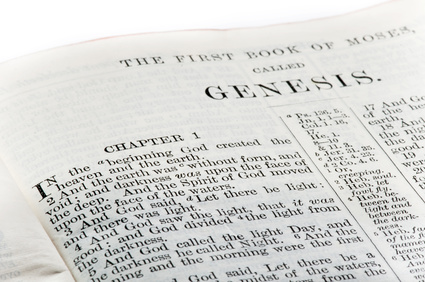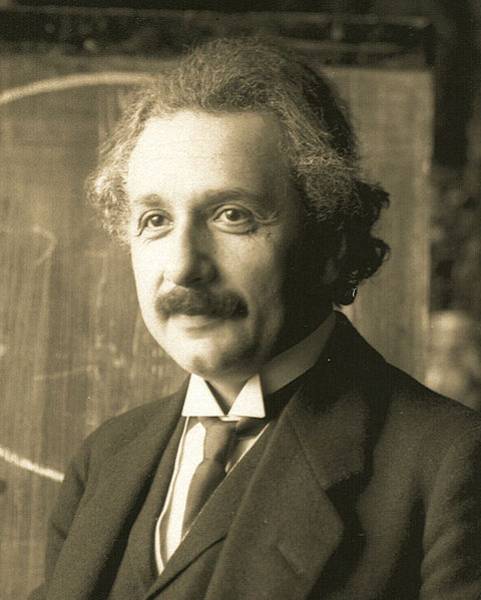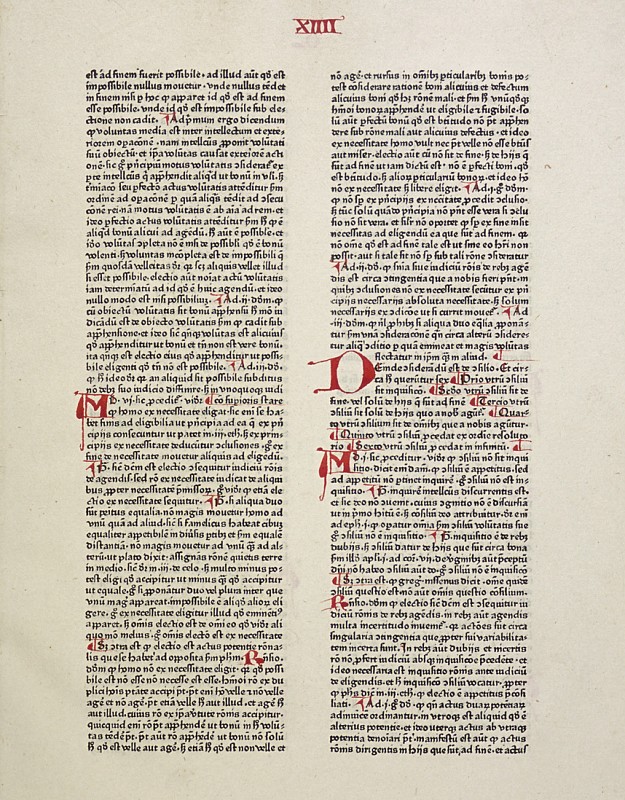Was the Big Bang Theory Born out of Belief? Lemaître’s Primeval Atom Hypothesis
Dominique Lambert
It was a physicist and catholic priest, father Georges Lemaître, who developed the nowadays widely hold idea that the universe had a beginning, named the “Bing Bang theory” by its critiques. What inspired him to assume this thought? Did science and faith meet in his scientific theories or how did he distinguish the two?
An important moment in Georges Lemaître’s life is certainly the First World War that began precisely after he got his Bachelor in engineering sciences in Louvain. He served immediately at the beginning of the War as a volunteer in Infantry and afterwards in Artillery. He was involved in important battles along the Yser river. When he was allowed to rest, Lemaître dedicated time for prayer and for reading many books. For example, he studied carefully the books of Poincaré, Electricité et Optique. Reading in details the latter, Lemaître wondered if the essence of the matter is made of particles (electrons) or waves (electromagnetic waves). He was searching some unifying foundation of the universe stuff. At the same time, Lemaître meditated the book of Psalms and the book of Genesis. He tempted to build for himself an exegesis of the three first verses of the Book of Genesis. This lead to a little essay entitled “Les trois premières paroles de Dieu” (“The three first words of God”) (Lemaître, 1996a). In the essay, he tried to give a symbolic meaning to the Biblical terms (water, light, …) referring to scientific concepts. For example, the Biblical light of the “fiat lux” constituted for him the fundamental reality existing at the very beginning and giving rise progressively to the matter by a kind of condensation. The Biblical text could thus here to be taken as a kind of a physical description.
The young soldier Lemaître spoke about his essay to some of his close friends. One of them, Joris van Severen, with whom he had many discussions, said in his notebook, on 17 April 1917, after having heard about this essay (Lambert 2007, 48):
« Lemaître will change all the Science…He will build a powerful and wonderful cosmogony »
On furlough in Paris, Lemaître presented his essay to the famous French writer Léon Bloy. Lemaître was fascinated by Bloy’s books in which he presented and defended the message of the Blessed Virgin of La Salette. Bloy convinced Lemaître to leave aside his symbolic exegesis mixing scientific concepts and biblical content, an “essay of scientific interpretation of the first verses of the Hexameron” he said (Lemaître 1996a, 109). During his life, Lemaître followed Bloy’s advice. Nevertheless, we can detect two occasions where the intuitions of “The three words of God” curiously surface in his purely scientific contributions.
The first occasion is at the end of his famous 1927 paper explaining what will be called the “Hubble Law” afterwards (Lemaître 1927). In a paragraph which has nothing to do with the rest of the paper, he suggests that the cause of the expansion of the universe could be the “pressure of radiation” due to the accumulation of light rays turning around in a closed universe. Curiously we find something similar in the essay, where light rays are seen to turn around also in the created world. Helge Kragh has well noted the cryptic and strange nature of this paragraph referring to the cause of the universe’s expansion (Kragh 2004, 130):
“Lemaître argued that the expanding universe needed a cause for its increasing departure from the static Einstein world. At the time he could not say what this cause was, except that it might have been ‘set up’ by the radiation itself, as he somewhat cryptically expressed it. Yet the mere willingness to look for a cause for the expansion is remarkable, as it underlines the physical nature of his model.”
The second occasion can be found in a paper (Lemaître 1930) which is very important in the genesis of the Primeval Atom Hypothesis. This paper was influenced by Millikan’s theory of Cosmic Rays. We know now that the famous American physicist did not accept the heat death of the universe predicted by the second law of thermodynamics. According to him this “death” could not be compatible with the Christian eschatology to which he was attached. With a collaborator, Harvey Cameron, they imagined a process that restores order in the universe in order to escape to the state of maximal entropy corresponding to the heat death (Kragh 2004, 90-92). It is interesting here to note that a religious belief motivates directly the construction of a new scientific theory. It is also worth noting that some time before, some scientists – like Svante Arrhenius, Nobel laureate in 1903 –, who were materialists, imagined an analog process in order to ensure an eternal stability of the universe’s structure (Kragh 2008, 165-166).
We have two opposite philosophical ideas leading to the same project in physics: to invent a “counterentropic” mechanism. Millikan and Cameron imagine that particles (protons and electrons) can be created from radiation being present in the universe, by a kind of condensation process. Spontaneously, these particles join together and the mass defect resulting of such a particle association is emitted under the form of radiations that Millikan and Cameron identify wrongly with Cosmic Rays. The particle condensation process can go on, from radiation, without end, avoiding the heat death. Lemaître, who got the opportunity to discuss with Millikan during his stay in the USA, was impressed by this hypothesis, but in his own considerations, he only kept the idea that particles are created from a radiation background. In 1930, he took into account the expansion of the universe (which modifies the wavelength of any radiation) to conclude that (Lemaître 1930, 182; Lambert 2015, 144):
“The possibility is now admissible that light was the primordial state of matter and that all matter condensed in stars was formed by the process proposed by Millikan.”
It is interesting to note here that Lemaître alluded to this primordial “light”. Like in his essay at war time, and in the conclusion of his 1927 paper, where he attributed – as we have seen – the cause of the expansion of the universe to the “light” pressure, he is convinced here that the origin of matter in the universe is radiation, is light! According to him, at the beginning of the world, we have thus an amount of light. We can now understand why, in 1931, Lemaître proposed considering the beginning of the universe from a unique primeval quantum that can be interpreted either as a wave (quantum of radiation) or as a particle (the famous Primeval Atom).
Probably the theme of light as the primordial stuff of the universe has played a role in Lemaître’s imagination. The biblical context is not used directly in Lemaître’s papers of course. But it is interesting to note that intuitions or images coming from his symbolic exegesis contribute to provide insights in a field he explored and where he did not know anything. Religious background plays the role here of providing intuition. Of course, when the theory was established, all these extra-scientific insights disappear with the context of discovery, leaving the place only to logical and empirical elements belonging to the scientific context of justification.
Science practice, however, is not only built on pure rational and logical foundations. When entering in unknown areas scientists need to be helped by some guides, some regulating ideas… Imagination, aesthetic considerations, philosophical assumptions and even religious (or sometimes anti-religious) prejudices can play some role providing such transitory guides.
At this point needs to be mentioned, however, that such “philosophical” or “religious” input has not to be confused with what we could call the real metaphysical structure or content of science. While we cannot deny that some religious background (related to the meaning and the primordial role of “light”) is at the very beginning entangled in our example with the process leading Lemaître to the idea of the primeval quantum. But we have to note two important things.
First, the event that provoked Lemaître’s 1931 paper (Lemaître 1931a) where he set out, for the first time, his idea of the Primeval Atom, was to some extent a reaction to a paper of Eddington who notified clearly his rejection of the idea of the beginning of the universe, because he believed that such a beginning was a theological idea; Eddington, however, confused creation and natural beginning (Eddington 1931). Lemaître’s paper gives an argument to show that there exists a legitimate purely scientific notion of the “natural beginning” of the universe (corresponding to a state of minimal entropy). Therefore, we can say that if there is something “religious” involved in the process leading to the primeval quantum (“light was the primordial state of matter”), it is a “secular” reaction to a misunderstood theological idea: what provoked the famous 1931 Lemaître’s paper is Eddington’s confusion of the initial physical state with the idea of a creation ex nihilo.
Secondly, we have to mention that what we have said does not mean that Lemaître wanted to deprive his hypothesis of any metaphysical or theological meaning. Not at all! But here he considered that this meaning was not immediately grasped, remaining at the level of mathematical and physical representations. He considered the theological content as valuable, but he also wanted to emphasize the fact that the deep theological meaning of God’s creation cannot be brought directly by physics. After having explained his purely scientific Primeval Atom Hypothesis in front of the participants of the Eleventh Solvay conference in 1958, he said clearly (Lemaître 1958, 7):
“It does not mean that cosmology has no meaning for philosophy.”
And during the time of the Council Vatican II, responding to a question of Msgr Edouard Massaux, the future Rector of the Catholic University of Louvain, concerning the origin of the Primeval Atom, Msgr Lemaître said (Lambert 2015, 150):
“Of course, the primeval atom is created by God!”
In order to understand the difference between “religious” motivations or backgrounds leading to new scientific ideas ideas and deep theological or metaphysical meaning of scientific contents (not confused or identified with these contents!) we have to think for example of Cantor’s theory of transfinite numbers. It is true that Cantor had a religious motivation in proposing his study of the infinite sets (the “aleph” symbol is a clue of that). But the real philosophical meaning or structure immanent to the theory of infinite sets has nothing to do with the initial Cantor’s motivation. There are deep philosophical issues that can be addressed from set theory and its rich and various axioms (for example: what is the ontological status of a set? What is the philosophical meaning of the axiom of choice, or the axiom saying that there exist infinite sets, and so on). But these legitimate and very interesting philosophical issues have nothing to do with Cantor’s will to find a mathematical approach to God’s attributes.
The healthy optimism of a physicist who was also a believer
During all his life, Georges Lemaître was convinced that the universe can be understood by human rationality. As early as in 1920-23, when he was at the Seminary, he expressed, in a manuscript entitled “La physique d’Einstein” the fact that universe is intelligible and perfectly adapted to our rational abilities (Lemaître 1996b, 226). For him, universe has to be finite! This is perfectly in line with his Thomistic training received at the Institute of philosophy of Louvain in 1919. At this point, he is in opposition to Blaise Pascal. In 1958 he explicitly said (Lemaître 1958, 7):
“The view we have proposed (the primeval atom hypothesis) may be contrasted with that of Pascal in the Pensées. We may reverse Pascal’s wording and say that the Universe not being infinite neither in size nor in duration, has some proportion to mankind. Science has not to surrender in face of the Universe and when Pascal tries to infer the existence of God from the supposed infinitude of Nature, we may think that he is looking in the wrong direction. There is no natural limitation to the power of mind. The Universe does not make an exception it is not outside of its grip.”
The conviction that universe has a structure that can be unveiled by human rationality is in fact rooted deeply in a religious belief. During a catholic congress in Malines in 1936, Canon Lemaître connected the task of unfolding the nature’s secrets with the discovery of some reflexes of God’s intelligence (Lemaître 1936, 65; translated from the French, de Felipe 2015):
“[...]. It is man’s task to understand and value the creation that surrounds him and to which he belongs, to perceive in it a reflection of the divine intelligence, by marveling at being surrounded by intelligible matter.”
Lemaître was certainly convinced that his scientific task contributes to unveil something (a vestigium) of a divine Logos. Furthermore, it is God who provides human beings with the ability to understand something of him through and from the empirical clues. At the end of a presentation of his cosmological ideas, the Belgian physicist said (Lemaître 1950, 55):
“We cannot end this rapid review which we have made together of the most magnificent subject that the human mind may be tempted to explore without being proud of these splendid endeavors of Science in the conquest of the Earth, and also without expressing our gratitude to One Who has said: ‘I am the Truth’, One Who gave us the mind to understand Him and to recognize a glimpse of His glory in our universe which He has so wonderfully adjusted to the mental power with which He has endowed us.”
According to Lemaître, science is the same for a believer and a non-believer. Nevertheless, the work of the believing scientist is strongly supported by the fact that, thanks to his faith, he knows that the enigma of the universe has a solution: the universe is comprehensible because it is created by an Intelligence. This gives a goal that maintain an optimism that is a necessary condition to continue the hard work of scientific activity. As he said (Lemaître 1936, 70; translated from the French, de Felipe 2015):
“He [the Christian researcher] may even have an edge over his unbelieving colleague. Both strive to puzzle out nature's multiply interlocked palimpsest, on which the many traces of the various eras of our world's long history overlap and merge. But the believer knows that the puzzle can be solved, that it has an underlying logic finally worked out by an intelligent being, that the problem posed by nature was designed to be solved, and that its difficulty is, without doubt, in the reach of our human abilities, be it today or tomorrow. This knowledge might not provide him with new investigation resources, but it will help him support the healthy optimism without which his effort cannot long endure.”
We see here, according to the testimony of Canon Lemaître, an important influence of religious belief on scientific research. Religious belief produces at the same time a psychological influence on the scientist (to know that there exists a deep intelligibility can strongly motivate the scientific enterprise) but also contributes helping him to express his fundamental assumption of the rationality of the universe and also of his unity.
The epistemological role of Philosophy and Christian Theology
Lemaître’s primeval atom hypothesis is a way to describe a natural (physical) beginning of the universe. Some physicists at his time and still today, and far from the least important ones, conflated this notion with a creation in a metaphysical or theological sense. Lemaître, thanks to his serious Thomistic training, knew that creation is a metaphysical relation by which God gives the existence to the world ex nihilo subjecti. Creation is not a question of beginning. In a text edited long after Lemaître’s death, but written in the end of the Thirties he said (Lemaître 1985, 47):
“What happened before that? Before that we have to face the zero value of the radius (of the universe) We have discussed how far it had to be taken as strictly zero, and we have seen that it means a very trifling quantity, let us say few light-hours. We may speak of this as of a beginning I do not say a creation. Physically it is a beginning in the sense that if something had happened before it, it has no observable influence on the behavior of our universe, as any feature of matter before this beginning has been completely lost by the extreme contraction at the theoretical zero. A pre-existence of the universe has a metaphysical character. Physically everything happens as if the theoretical zero was really a beginning. The question if it was really a beginning or rather a creation: something starting from nothing, is a philosophical question that cannot be settled by physical or astronomical considerations”.
Thomistic philosophy gives him a tool to avoid an epistemological confusion and to feel free to explore cosmological models with initial singularity. According to Georges Lemaître’s epistemology, natural beginning can be entirely described by scientific methods and therefore can be adopted by believers but also by materialists. After having presented his Primeval Atom Hypothesis during the 1958 Solvay Conference, he continues saying (Lemaître 1958, 7):
“This is the philosophical background of the Primeval Atom hypothesis. As far as I can see, such a theory remains entirely outside any metaphysical or religious question. It leaves the materialist free to deny any transcendental Being. He may keep, for the bottom of space-time, the same attitude of mind he has been able to adopt for events occurring in non-singular places in space-time. For a believer, it removes any attempt to familiarity with God, as were Laplace’s chiquenaude or Jeans’ finger. It is consonant with the wording of Isaias speaking of the ‘Hidden God’, hidden even in the beginning of creature. It does not mean that cosmology has no meaning for philosophy…”
This attitude was already the one he expressed in his unpublished conclusion to his 1931 paper in Nature. The latter does not refer to any philosophical background. He left open the metaphysical questions that remained hidden (Georges Lemaître 1931b):
“I think that every one who believes in a supreme being supporting every being and every acting believes also that God is essentially hidden and may be glad to see how present physics provides a veil hiding the creation”
What is important for our aim here is the fact that Christian philosophy can bring with it some very interesting conceptual tools that are not easily available in other ones. For example, in traditions where creation is not present or even rejected, it is not easy to find some fine nuances helping to distinguish between natural beginning, ontological beginning and creation. Christian philosophy was in a certain sense obliged to think about creation, origin, beginning, etc. During his career, Lemaître’s training was very useful to defend the scientific autonomy of his cosmological approach and to protect his theological convictions against dangerous confusions between immanence and transcendence.
It is interesting to note that theology can imply some philosophical requirements that reveal themselves to be coherent with the interpretation of some scientific descriptions. For example, Christian theology of creation is not compatible with a world history that would be completely a priori determined like Spinoza’s Substance. It would be as well not coherent with an anthropology deprived of free-will. In Lemaître’s cosmology, all the empirical world history is coming from the Primeval Atom, but contrary to the Spinozist Substance (Natura), this history is not predetermined. The disintegrations of the Primeval Atom that give rise to space, time and matter, are completely unpredictable (Lemaître 1967, 161; our translation):
“In Laplace’s determinism, everything is written, evolution is similar to the implacable rotation of a recorded magnetic tape or the engraved spiral of a phonograph disc. Everything that would be heard would have been read from the tape or the disc. It is quite another story with the advent of modern physics and, according to the present theory these concepts should also apply to the universe, at least to the beginning of its evolution. This beginning is perfectly simple, indivisible, undifferentiated, “atomic” in the Greek sense of this world. The world differentiates as it evolves; it does not consist in the spinning out, the decoding of a recording. Rather it consists in a song, each note of which is new and unpredictable. The world made itself and made itself randomly.”
Random processes are the trace of some contingency. Necessity and contingency are both present in Lemaître’s wonderful cosmogony as well as in Thomas Aquinas philosophy. To sum up, we can say that Thomistic philosophy plays two major roles in the context of Lemaître’s cosmological work. First, it serves to provide some conceptual distinctions that are not or few present in other traditions (where the concept of creation is absent or denied). Secondly, it gives some requirements that are not directly imposed to the physical description of the world but that happen to be coherent with it (random processes are clues for the existence of contingency). There is no direct confusion of science and theology, because the first point precisely helps to avoid such confusion and the second point can only be checked a posteriori showing (and not building or forcing!) a coherence between philosophical requirements of theological content and philosophical interpretations of scientific data or theories.
Dominique Lambert
Université de Namur (Institut ESPHIN); Académie Royale de Belgique
Published September 2017
We also offer a German translation of the article.
Bibliography
de Felipe. P. 2015. “Georges Lemaître's 1936 Lecture on Science and Faith”. Science and Christian Belief, 27:154-179.
Eddington, Arthur. 1931. “The End of the World from the Standpoint of Mathematical Physics”. Supplement to Nature. March, nr 3203: 447-453.
Kragh, Helge. 2004. Matter and Spirit in the Universe. Scientific and Religious Preludes to Modern Cosmology. London: Imperial College Press.
Kragh, Helge. 2008. Entropic Creation. Religious Contexts of Thermodynamics and Cosmology. Burlington: Ashgate Publishing Company.
Lambert, Dominique. 2007. L’itinéraire spirituel de Georges Lemaître. Suivi de Univers et Atome, Conférence inédite de Georges Lemaître. Bruxelles: Lessius.
Lambert, Dominique. 2015. The Atom of the Universe. The Life and Work of Georges Lemaître (preface by J. Peebles). Cracow: Copernicus Center Press.
Lemaître, Georges. 1927. “Un univers homogène de masse constante et de rayon croissant, rendant compte de la vitesse radiale des nébuleuses extragalactiques (séance du 25 avril 1927)”. Annales de la Société Scientifique de Bruxelles, série A: Sciences Mathématiques, 1ère partie: Comptes rendus des Séances. XLVII: 49-59.
Lemaître, Georges. 1930. “L’hypothèse de Millikan-Cameron dans un univers de rayon variable”. In Comptes rendus du Congrès national des sciences organisé par la fédération belge des sociétés scientifiques. Bruxelles, 29 Juin-2 Juillet 1930, 180-182. Bruxelles : Fédération Belge des Sociétés Scientifiques.
Lemaître, Georges. 1931a. “The beginning of the world from the point of view of quantum theory”. Nature, CXXVII: 706
Lemaître, Georges. 1931b. Unedited conclusion of the paper: Lemaître, Georges. 1931. “The beginning of the world from the point of view of quantum theory”. Nature, CXXVII: 706. Louvain-la-Neuve: Archives Lemaître. Lemaître, Georges. 1936. “La culture catholique et les sciences positives” (séance du 10 septembre 1936). In Actes du VIe congrès catholique de Malines, Vol. 5, Culture intellectuelle et sens chrétien, 65-70. Bruxelles: VIe Congrès Catholique de Malines.
Lemaître, Georges. 1950. The primeval atom: A hypothesis of the origin of the universe (translated by B.H. Korff and S.A. Korff, with an introduction by H.N. Russell), New York-London: Van Nostrand Company.
Lemaître, Georges. 1958. “The primaeval atom hypothesis and the problem of the clusters of galaxies”. In La structure et l'évolution de l'univers Rapports et discussions. Onzième Conseil de physique tenu à l'Université de Bruxelles du 9 au 13 Juin 1958, 1-25. Bruxelles : R. Stoops.
Lemaître, Georges. 1967. “L’expansion de l’univers: réponse à des questions posées par Radio Canada le 15 avril 1966”. Revue des questions scientifiques, CXXX- VIII, 5e série, XXVIII, avril 1967, no 2: 153-162, (version edited and adapted by O. Godart).
Lemaître, Georges. 1985. The expanding universe : Lemaîtres unknown manuscript (introduction by O. Godart and M. Heller). Tucson (Arizona) : Pachart Publishing House.
Lemaître, Georges. 1996a. “Les trois premières paroles de Dieu”. In Mgr Georges Lemaître savant et croyant. Actes du colloque tenu à Louvain-la-Neuve le 4 novembre 1994, suivi de La Physique d’Einstein, texte inédit de Georges Lemaître, edited by J.-F. Stoffel, 107-111. Louvain-la-Neuve: Centre Interfacultaire en Histoire des Sciences.
Lemaître, Georges. 1996b. “La physique d’Einstein”. In Mgr Georges Lemaître savant et croyant. Actes du colloque tenu à Louvain-la-Neuve le 4 novembre 1994, suivi de La Physique d’Einstein, texte inédit de Georges Lemaître, edited by J.-F. Stoffel, 223-360. Louvain-la-Neuve: Centre Interfacultaire en Histoire des Sciences.
Picture Credits
Georges Lemaître (1894–1966), Belgian priest, astronomer and professor of physics at the Catholic University of Leuven. (Estimated date of photography: 1933.) (c) Wikimedia Commons
Sun Rays #64444718 (c) Fotolia.com | Peter Hermes Furian
Start of the Book of Genesis from the King James Bible. #28996290 (c) Fotolia.com | habari
Page of a mediaval manuscript of Thomas of Aquin's „Summa Theologica“ (c) Wikimedia Commons















